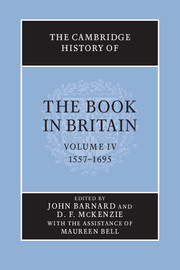Book contents
- Frontmatter
- Dedication
- Contents
- List of illustrations
- List of contributors
- Preface
- Acknowledgements
- Introduction
- RELIGION AND POLITICS
- ORAL TRADITIONS AND SCRIBAL CULTURE
- LITERATURE OF THE LEARNED
- 6 The Latin trade
- 7 Patronage and the printing of learned works for the author
- 8 University printing at Oxford and Cambridge
- 9 Editing the past: classical and historical scholarship
- 10 Maps and Atlases
- 11 The literature of travel
- 12 Science and the book
- 13 Samuel Hartlib and the commonwealth of learning
- 14 Ownership: private and public libraries
- 15 Monastic collections and their dispersal
- LITERARY CANONS
- VERNACULAR TRADITIONS
- THE BUSINESS OF PRINT AND THE SPACE OF READING
- BEYOND LONDON: PRODUCTION, DISTRIBUTION, RECEPTION
- DISRUPTION AND RESTRUCTURING: THE LATE SEVENTEENTH-CENTURY BOOK TRADE
- STATISTICAL APPENDICES
- Abbreviations
- Bibliography
- Index
- Plate Section
- References
11 - The literature of travel
from LITERATURE OF THE LEARNED
- Frontmatter
- Dedication
- Contents
- List of illustrations
- List of contributors
- Preface
- Acknowledgements
- Introduction
- RELIGION AND POLITICS
- ORAL TRADITIONS AND SCRIBAL CULTURE
- LITERATURE OF THE LEARNED
- 6 The Latin trade
- 7 Patronage and the printing of learned works for the author
- 8 University printing at Oxford and Cambridge
- 9 Editing the past: classical and historical scholarship
- 10 Maps and Atlases
- 11 The literature of travel
- 12 Science and the book
- 13 Samuel Hartlib and the commonwealth of learning
- 14 Ownership: private and public libraries
- 15 Monastic collections and their dispersal
- LITERARY CANONS
- VERNACULAR TRADITIONS
- THE BUSINESS OF PRINT AND THE SPACE OF READING
- BEYOND LONDON: PRODUCTION, DISTRIBUTION, RECEPTION
- DISRUPTION AND RESTRUCTURING: THE LATE SEVENTEENTH-CENTURY BOOK TRADE
- STATISTICAL APPENDICES
- Abbreviations
- Bibliography
- Index
- Plate Section
- References
Summary
Various kinds of ‘private’ and ‘public’ forms of book production were commonly utilized to preserve experiences of travel. The compilation of manuscript volumes, which far exceeded the production of printed books, is of crucial importance in any consideration of the readership of travel literature between 1557 and 1695. Indeed, no first-hand significant account of travels in Europe by an Englishman reached print before 1600 despite the frequent publication in these years of translations of major works by foreigners (translation remained a key source for texts throughout the period). Some of these manuscripts were probably written as private reference manuals and some circulated only in manuscript. On some occasions conflicting accounts might be circulating simultaneously in manuscript and print. In print the choices available to an author or bookseller ranged from sensationalist single sheet ballads, hastily printed newsletters, crudely printed pamphlets, populist publications and handy pocket guides in slim octavo and duodecimo, to expensive and lavishly illustrated quartos and folios aimed at the wealthy individual purchaser or institutional libraries. Later, following the Restoration, accounts of individual journeys were usually published in folio. But from the mid-1570s there had been a large selection of guide books, including cheaply printed narratives, available to anyone travelling in Europe for education or pleasure as opposed to business.
Keywords
- Type
- Chapter
- Information
- The Cambridge History of the Book in Britain , pp. 246 - 273Publisher: Cambridge University PressPrint publication year: 2002
References
- 4
- Cited by

